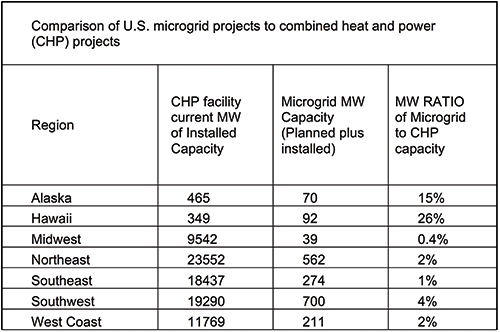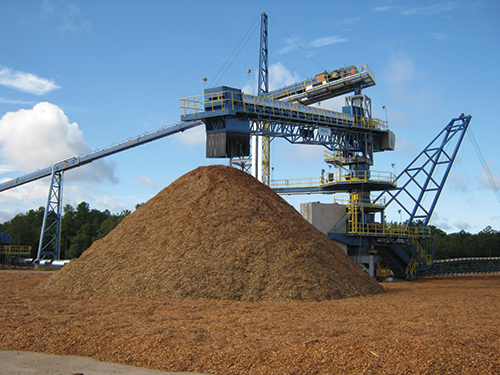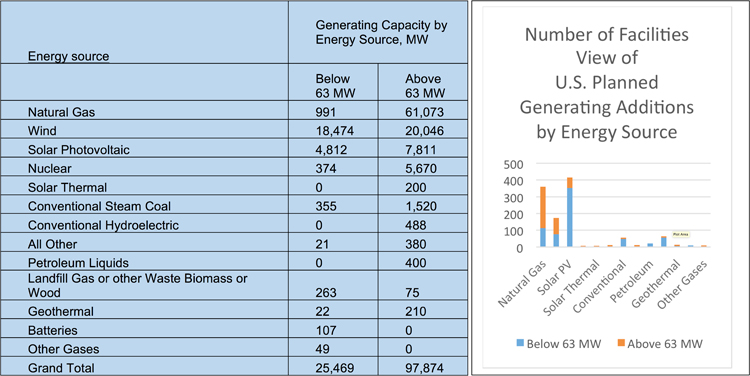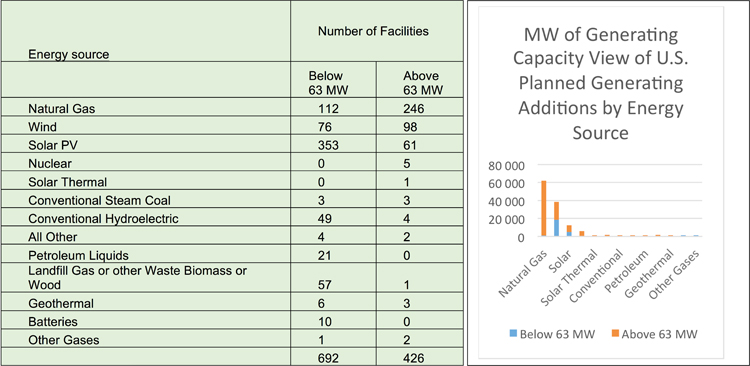Taking a Macro View of Microgrid Trends
New microgrid installations, along with related growth trends in wind, solar, and energy storage, have been given a great deal of attention recently. The engineering challenges and business issues that need to be addressed to ensure a successful microgrid project include the following five pillars, which we will detail below:
Microgrid Project Success Factors:
- ‘Future-proof’ your design
- Size your facility correctly
- Maximize potential ROI
- Ensure project plans meet your overall goals
- Teamwork, teamwork and more teamwork!
Before detailing these key elements of microgrid projects, we will first describe the overall macrogrid business and engineering context. This will help us to see and prioritize key challenges associated with microgrids, renewable sources of energy, and energy storage, given the actual size of certain smaller portions of the power generation market in relation to larger ones.
Why is it important to take this type of ‘macro’ view of microgrid trends? Because it seems that a lot of the current discussions about microgrids involve hype, where we can define hype as something that would give a naïve person unrealistic expectations at best, and some seriously incorrect ideas at worst. (Among the latter we can include the mistaken notion that our current grid’s centralized generating plants and associated transmission and substation infrastructure were based on some sort of design mistake or outright bias.)
To counter misconceptions and unrealistic expectations about microgrids, we need to remember that the reliable electric service we receive today is the result of benefits accrued over more than 100 years of growth in centralized electric generation and T&D infrastructure. It was ‘macrogrid’ based infrastructure that created much-needed economies of scale that fueled our industry’s growth, by linking diverse customer loads together.
Definitions of Microgrids
What constitutes a microgrid? Some apply a size-based definition, suggesting a microgrid has to be below 50 MW. But a more functional definition that has stood the test of time is the one provided by Steve Bossart, Senior Energy Analyst, at the DOE’s National Energy Technology Laboratory:
“A microgrid is a group of interconnected loads and distributed energy resources within clearly defined electrical boundaries that acts as a single controllable entity with respect to the grid. A microgrid can connect and disconnect from the grid to enable it to operate in both grid-connected or island-mode.”1
Microgrid ownership categories are described in a recent study which used three groups and-subgroups:
- Utility microgrids
- Full utility microgrid
- Hybrid utility microgrid
- Own-use microgrid
- Energy service provider microgrids
- Landlord/tenant microgrid
- Owner/merchant microgrid
- Independent provider microgrid2
Debunking Key Myths About Microgrids
If microgrid-related challenges are addressed well, the potential long-term benefits are indeed impressive. But first we need to debunk a few myths.
Myth #1--We can all disconnect from the grid and operate as islands with renewable-based microgrids:
It is true that some of the regions with relatively larger portions of their electric service coming from microgrids are either literally islands (such as Hawaii and also Kodiak Island in Alaska), or are islanded electrically for other geographic reasons. Even if we could all switch to microgrids in the near future, we would be dealing with some serious cost issues and other difficulties! In addition, currently two non-renewable energy fuel sources--diesel and natural gas—power most microgrids. While microgrids hold the promise of enabling greater utilization of renewable sources of power, to maintain reliable service in such a world, transmission system interconnections will need to increase, not decrease, so as to deliver renewables-based power where and when it is needed most.
Myth #2—Microgrids may not be mostly renewables-based now, but they are becoming mainly a “renewables” and/or “storage” play:
Those who believe this transition is well-underway should answer the following three questions.
Q1: In the U.S., in which year did the total kWhr of electricity generated by wind and solar first exceed the total kWhr generated by hydro?
- 2014
- 2015
- None of the above.
Q2: What portion of the 1,560 energy storage projects in the DOE global energy storage project database have microgrid capabilities?
- More than 75%
- Between 25% and 75%
- Less than 25%
Q3: Which source of renewable energy do you think produced the most electric energy in recent years? Is it Wind, or Solar, or Hydro, or Biomass? 3
Microgrids and Renewables: Market Drivers and Segment Sizes
Table 1 shows the most recent Energy Information Administration data on relative amounts of electric energy generated from various renewable-based sources in the U.S.
Several things should be noted: First, while growth rates for solar and wind have been impressive, over-emphasizing growth rates without looking at the relative sizes of the segments clouds the fact that more energy was still generated via hydro in 2015, than by wind and solar combined. (In this regard, given the pace of change as shown on the right column in Table 1, 2016 may be the ‘cross-over’ year for the U.S., where wind and solar combined overtake hydro).
Table 1: Relative sizes of segments of U.S. generation of renewable-based electric energy

(Source: U.S. Energy Information Administration 2015 Annual Energy Outlook) 4
Second, we should not fall into the ‘number of projects’ versus ‘size of projects’ trap. This is highlighted by the side-by-side comparison below, where wind and solar projects look big vs. non-renewable sources, when shown based on the relative number of projects, but look small when the same data is displayed based on MW of capacity involved:
Finally, we should not neglect the huge contribution to renewables being made by biomass sources. Local microgrids associated with biomass create significant environmental benefits. Methane leaks from rotting biomass and, as stated in Scientific American, methane ‘is among the more potent greenhouse gasses.’ In addition, the regions where the biomass is generated are often far from populated areas and biofuels are often too bulky to be transported long distances economically.
You may ask why we should consider biomass to be clean or renewable. Some considerations:
- With landfill gas, not capturing and using it leads to leakage into the atmosphere, which is dirtier than burning it.
- In the case of wood-based biomass, it is clean because of the high efficiency levels of the cogenerating plants that use pulpwood materials left over after paper production.
- Biomass sources are renewable not only because the pulpwood trees employed in this process grow to maturity in 10 to 15 years – less than half the lifespan of the generating facilities involved.
- The carbon in the wood derived through photosynthesis, which involved the leaves pulling CO2 out of the atmosphere, thereby making the burning of that wood a net zero process.
- Ongoing pulpwood reforestation continues pulling additional CO2 out of the atmosphere.
The biggest per kWhr contributor to the biomass-based portion of renewable electric generation category is from wood energy, which includes electricity generated by pulp and paper mills.
Microgrid cogenerating facilities make efficient use of renewables in other favorable ways. It is even more favorable, not only because trees are being replanted systematically, but also because of CO2 and waste reductions associated with utilizing recycled materials.
Microgrids and Combined Heat and Power Facilities (CHPs)
A significant portion of the business and operational benefits associated with microgrids have been in play since before the 1970s, and often involved much larger installations: Combined Heat and Power facilities (CHP).
CHP installations generate electricity and recover associated ‘waste’ heat to a much greater degree than conventional power plants of the past, and put this ‘waste’ heat to good use. CHPs are also known as cogeneration plants, and they have been achieving impressive efficiency improvements. In contrast to the many older cogenerating facilities in the U.S, these types of facilities below 50 MW in size are in the microgrid category size-wise. As detailed in the U.S. Department of Energy’s CHP database, there are currently 4,808 CHP facilities in the U.S.
A trend in CHPs with important beneficial consequences for the microgrid market is the movement toward smaller and smaller CHP facilities. This trend is evident in the following table:5

In comparison to microgrids, the CHP market is very mature and large, as highlighted in the following comparison of data from the DOE database to a Greentech Media (GTM) microgrid report:6

Table created for Electric Energy T&D Magazine by author, from the DOE and GTM data sources listed at the end of the article.
A recent project of ours at ASSET Engineering involved substation upgrades we carried out at a biomass plant, located in Dublin, GA. The plant is 34MW in size.

Green Power Solutions, Dublin, GA Power Plant Generation Interconnection ASSET Engineering
The Dublin, GA facility operates as a grid-connected CHP microgrid, providing 34MW of base load power to the Georgia Transmission grid while also providing steam for use in the processing of recycled fiber. In order to take advantage of the renewable resource aspect of the steam generation at the SP Fiber Technologies Facility, the generation connected to the SPFT 138kV Bus needed to be reconfigured to connect to the Georgia Transmission 138kV transmission system. The increases in plant efficiency associated with these types of up-to-date cogeneration facilities are impressive. The Green Power Solution plant uses steam cogenerated during electricity production to facilitate treatment of the recycled wood products, thereby putting heat to use which could otherwise have been wasted, and reducing landfill and other waste if the materials hadn’t been recycled.
Along with CHPs, other facilities requiring critical power are also good candidates for microgrids.
Business and Engineering Success Drivers for Microgrid Projects
System integration capabilities play a key role in the success of microgrid projects. Since there is a lot of overlap between microgrids and traditional projects across these eight segments, a lot of the specialized engineering and system integration and design expertise required to ensure a successful microgrid project can be found in play in projects done for these areas.
The range of issues involved include addressing voltage stabilization and voltage regulation requirements, optimizing arrangements sale of excess power to support nearby loads, and satisfying all reliability concerns that the customer may have. Voltage regulation presents an opportunity as well as a challenge, given the dynamic changes occurring in regional load profiles and the generating facilities meeting demand.
While microgrids can help stabilize the grid they can also introduce instabilities, especially if their separation and reconnection to the macrogrid is not optimized with respect to grid performance in relation to fault events. In addition, designers are always on the watch for unintended resonance from inverter-based generators and seek optimal ways to avoid it.
While utilities participate directly in serving these needs, as well as their being served by Engineering, Procurement and Construction (EPC) companies who also provide this expertise. The EPC market consists of a wide range of players of diverse sizes, working for and with utilities and utility customers.
Due to the high demand for this type of specialized engineering talent, along with varying workloads, many EPC firms (including the largest ones) subcontract smaller engineering firms for specific engineering design and controls system expertise. The issues involved in substation design for renewables, data centers, and microgrids overlap in numerous ways. As a result, decision-makers need to weigh a wide range of factors in evaluating solution and service providers for microgrid related projects.
Microgrid Project Success Factors:
1. ‘Future-proof’ your design: Designs need to consider expected growth and future needs for the service area and flexibly address a range of scenarios.
Microgrid designs vary a great deal as a function of the type of facilities involved. Key categories for microgrids include:
- Campus / Institutional
- Commercial / Industrial
- Community
- Critical Services / Resilience
- Datacenter
- Military
- Remote
- Utility distribution
Since designs are not always ‘greenfield’ but also frequently involve upgrading existing infrastructure, cost savings and reliability benefits can be achieved by leveraging the ability of highly experienced engineering design personnel to adapt existing electrical infrastructure, including protection and control systems, while maximizing reliability and updating/ adding new equipment optimally.
2. Size your facility correctly: It is vital to ensure design decisions regarding a microgrid project take into account good models of load patterns and usage needs for electricity and ancillary energy requirements (steam, hot water, etc.) across all applicable load pattern variables (hourly, daily, monthly, seasonal). All measurements should be triple-checked and no key assumptions should be left unquestioned. It is helpful to dig into data sources deeply (e.g. building management systems and paper as well as electronically-logged data).
3. Maximize potential ROI: Ensure all applicable peak reduction Demand Response DR program incentives, and utility and regional rebates and tax credits, are considered in the design decisions. For example, based on specific criteria, Consolidated Edison of NY has provided rebates of up to 50 percent of the capacity costs for installation of microgrids in NYC (to the tune of $1,200 per kW). In addition, forecasting utility rates and modeling operating costs and avoided costs, as part of an overall energy and business model require a great deal of expertise.
4. Ensure project plans meet your overall goals: Goals to consider along with construction plans include resiliency, emissions reduction, reliability, dispatchability, etc., and should be included in the processes employed to prioritize design choices regarding generating technology. The cost/ benefit outcomes for inclusion of storage with wind or solar, for example, will vary depending on dispatchability goals and options. And in the case of high-efficiency combined heat and power (CHP) facilities detailed below, the choice of prime mover requires significant engineering design analysis to ensure site needs are optimally matched with different output profiles based on choice of generating technology.
5. Teamwork, teamwork and more teamwork!: Good teamwork requires building bonds of trust across complex teams and with local utility personnel, as well as numerous stakeholders across the local and regional jurisdictions, local business and community representatives. Keeping in ongoing communication with all key groups is essential. These types of projects can involve a wide range of different contributors from different participants in the project, and being able to collaborate and share data and keep communications open requires creation of a strong culture based on trust. Ensuring successful flexible designs that reliably switch back and forth between island and grid-connected modes requires high levels of cooperation and experience in working with the local utilities and any third-party subcontractors, as well as project management personnel from Engineering, Procurement and Construction (EPC) firms when involved.
APPENDIX
Table 1 – Analysis of Energy Information Administration data regarding U.S. plant additions, 2015, based on Generating Capacity by Energy Source, MW
Table 2: Analysis of Energy Information Administration data regarding U.S. plant additions, 2015, based on Number of Facilities
About the Author
 Ron Reed is Vice President of Business Development at ASSET Engineering, in the Jackson, Mississippi area, and has more than 30 years of experience in project management, engineering and business development in energy, chemical, forest products and land development sectors. Ron has been addressing challenging engineering and business requirements while building long-term partnerships, as well as providing innovative solutions for clients, and developing high-performing teams by fostering a results-oriented environment. ron.reed@assetcompany.com
Ron Reed is Vice President of Business Development at ASSET Engineering, in the Jackson, Mississippi area, and has more than 30 years of experience in project management, engineering and business development in energy, chemical, forest products and land development sectors. Ron has been addressing challenging engineering and business requirements while building long-term partnerships, as well as providing innovative solutions for clients, and developing high-performing teams by fostering a results-oriented environment. ron.reed@assetcompany.com
References
2 (Source: Microgrids-for-Critical-Facility Resiliency in NY State, NYSERDA, Page 109)
3 ANSWERS Q1: It turns out that biomass is by far the largest contributor to renewables-based electric energy being generated in the U.S. For many years, biomass has been providing 50% of all renewable-based electric energy generated in the U.S.
Q2: The answer is (c), since only 160 out of the 1,560 projects include microgrid capabilities. In fact this “below 10% by project” figure is even lower—only one percent—if we rank the 1,560 projects by MW capacity.
Q3: The answer is (c), because Hydro by itself still provides more electric energy than wind and solar combined. Despite the recent growth of wind and solar capacity installations, it turns out that in 2015, more kWhr of electric energy were generated by hydro power in the U.S. than by wind and solar combined.
4 U.S. Energy Information Administration, May 2016 Monthly Energy Review--Table 1.2: Primary Energy Production by Source
5 Source: Author’s analysis of DOE database: https://doe.icfwebservices.com/chpdb/state/ID
6 GTM source URL: http://www.ourenergypolicy.org/wp-content/uploads/2015/07/North-American-Microgrids-2015-brochure.pdf
DOE Source URL: https://doe.icfwebservices.com/chpdb/state/ID










